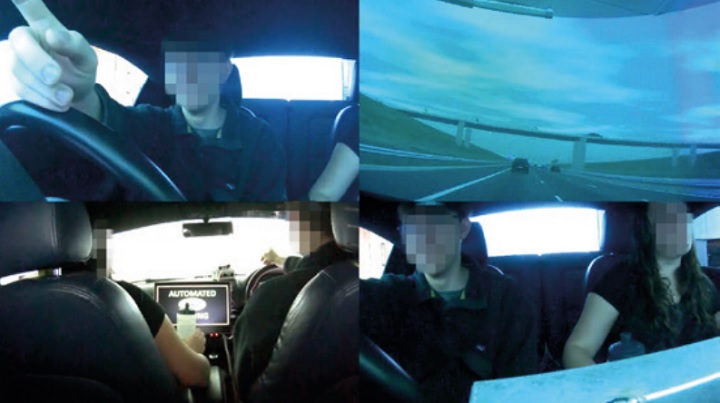
A simulator study shows the presence of a passenger can improve drivers’ focus on the road and help them to decide when manual control is needed in self-driving vehicles, but taking back control is still difficult.
Having a front seat passenger in the vehicle was found to aid in giving directions and prevent drivers from falling asleep in the vehicles, but also created more distractions for drivers during periods of automation.
The findings come from a University of Nottingham study for the RAC Foundation into the behaviour of 17 motorists, each accompanied by a front seat passenger, who made a number of trips in a driving simulator programmed to represent a so-called Level 3 automated vehicle.
In the hierarchy of vehicle automation Level 3 is known as conditional automation where, in certain circumstances, the vehicle will drive itself completely and allow the person behind the wheel to do another task, but in some scenarios it will hand back control to the driver.
Fully automated driving was only available on the motorway legs of the simulated trips.
Occupants spent a lot of time in conversation with each other and also on their tech – predominantly smart-phones and -watches – often showing one another the content. Some pairs watched films together and even played online chess against each other whilst the car was driving.
On more than one occasion the pair was so absorbed in their activities that they missed their turn-off from the motorway.
However, passengers were also observed to be good moderators, encouraging drivers to keep an eye on the road ahead even when they weren’t driving and stopping them from taking a nap.
Nevertheless, when interviewed afterwards, passengers were “acutely aware of the potential distraction they posed to the driver, recognising that the driver was ultimately in control of the vehicle.”
The researchers also observed that “vehicular control during the ten seconds immediately after resuming manual driving was generally poor in the case of all participants.”
The drivers were seen braking and accelerating erratically, and wavering in their lanes in the immediate aftermath of taking back manual control of the vehicle, despite the support of their passenger.
The study team believe that in some cases the exaggerated inputs into the pedals and steering wheel might have been the driver demonstrating to “their passenger that they were now in control.”
The findings from this report can now be used to inform future studies into conditional automation and help make self-driving vehicles safer for road use.
The authors also suggest that future work should uncover nuances in behaviour associated with different groups, such as young drivers, where the presence of passengers has not traditionally been found to support safer road use.
Steve Gooding, director of the RAC Foundation, said: “Many motorists will be used to the unwanted contributions of a proverbial ‘backseat driver’ but this research shows that when it comes to controlling a semi-autonomous car a front-seat passenger might genuinely help the person behind the wheel.
“It’s hard to argue against the ambition for fully driverless cars to make our roads safer by eliminating the human errors which contribute to collisions. But many still doubt whether fully automated driving – on any road, at any time, and anywhere – is a realistic aim.
“Meantime the transition to a world where the driver of the car becomes the passenger at least some of the time raises important questions about the human-machine interface.”
On 20 May 2024 the Automated Vehicle Bill received Royal Assent paving the way for fully autonomous cars on UK roads.
Automated Lane Keeping Systems (ALKS) are already cleared for use in the UK. ALKS is a fully-automated system, initially allowed for use at slow speeds, but in other situations the driver will have full control of the car.
Dr David R Large, senior research fellow at the Human Factors Research Group at the University of Nottingham, said: “The presence of passengers has been shown to distract drivers during manual driving, so this study allowed us to identify whether the same could be said for conditional automation.
“Our study highlighted the distraction that passengers continue to pose inside these vehicles, but also the value they can offer. We observed passengers providing help and assistance to drivers during manual takeovers of the vehicles, and sharing the responsibility of keeping the focus on the road when needed.
“The findings of this study will allow us to further explore the risks of conditional automation and how the technology of the vehicle can be improved to increase their safety on our roads.”
Comment on this story